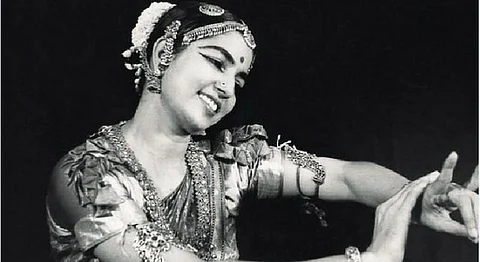
- HOMEGROWN WORLD
- #HGCREATORS
- #HGEXPLORE
- #HGVOICES
- #HGSHOP
- CAREERS
- ABOUT US
- CONTACT US

To be an artist in any form requires passion. To successfully make it a career you need to be able to face society with complete conviction and defend your choice, especially in an art-deprecating country like India. Today, it has become ever so slightly less stigmatised and the mention of a life in the arts will still raise eyebrows but in the early 1900’s the idea of anyone - especially a woman of standing - entering an artistic field was nothing less than a scandal, but that’s exactly how Rukmini Devi Arundale came to be one of India’s unsung heroines.
Born in 1904 to a well-to-do Brahmin family in Madurai, Tamil Nadu she was one of eight children. Her mother was a music-lover and her father was a Sanskrit Scholar and engineer who had close ties with the Madras-based Theosophical Society. She took a lot of interest in her father’s work and it was through his work that she first came in contact with nationalist and women’s rights activist Annie Besant, who co-founded the institution.
At the age of 16 she fell in love and married Besant’s trusted lieutenant, educator George Arundale. Together they travelled the world spreading their theosophical missions and it was during this time that she first discovered her love for dance. On a ship bound for Australia, Rukmini met the Russian Prima Ballerina, Anna Pavlova whose grace and skill enthralled her. Upon Pavlova’s request she began taking ballet classes and was advised to explore her talent further by looking to classical Indian dance forms for inspiration.
With Pavlova’s words to embolden her Rukmini embarked upon her mission to conquer and promote the art of Bharatanatayam. Traditionally the dance had been associated with temple Devadasis and most upper class girls were forbidden from practicing it. Rukmini’s goal was to revive the suffering dance form, restore it to its former glory and remove the negative stereotypes surrounding it.
After completing her formal training with Pandanallur Meenakshi Sundaram Pillai she gave her first public performance in 1935 before the Theosophical Society. When she took the stage she shattered stereotypes and opened the doors for all Indian women with a passion for dance.
In the years to follow, Rukmini devoted herself to the revival of these classical dance forms. At her Kalakshetra Foundation she educated girls both in traditional academics and in a range of dance forms. She even expanded to teaching the arts of jewellery making, weaving and sari dyeing to increase the dance’s appeal.
As a celebrated artiste and the foremost revivalist of Indian classical dance Rukmini was awarded the Padma Bhushan in 1956 and the Sangeet Natak Akademi Award in 1967. One of her other great achievements was her pivotal role in the passing of the Prevention of Cruelty to Animals Act in 1952 as the first Chairperson of the Animal Welfare Board.
Through all this recognition and success she never once wavered from her goal and dance was her first and last love. It’s said that after the death of President Fakhruddin Ali Ahmed in 1977 the then-Prime Minister, Morarji Desai, asked Rukmini Devi to take up the post. It was reported that to this request she replied with the question, “President of what?” “President of India” replied Desai.
Rukmini understood only too well what a life in politics would mean and how the trappings of office would reflect on her work at Kalakshetra so she politely declined the offer. Years later, in 2013 President Pranab Mukherjee recounted this story during the during the inauguration of the Rukmini Devi Memorial Lecture at Kalakshetra.
“I was a Congress MP at the time and Morarji Desai proposed that Rukmini Devi fill the vacancy caused by the death of President Fakhruddin Ali Ahmed. The choice was very widely appreciated and if she agreed, she would have been elected unanimously. But her refusal spoke volumes of her character, wisdom and sagacity and exemplified the values of renunciation and sacrifice that India has traditionally inculcated.”
— - Pranab Mukherjee
Until she passed away in 1986 Rukmini Devi stood as a testament to grace and determination. Even today her headstrong attitude and passion for dance inspire generations of classical dancers. To be offered up a chance at power and to decline willingly is not a trait we see often in modern times. It was her ability to give wholeheartedly to her craft without fearing the temptation of wealth, fame or power is what makes Rukmini Devi’s story one worth keeping alive.
